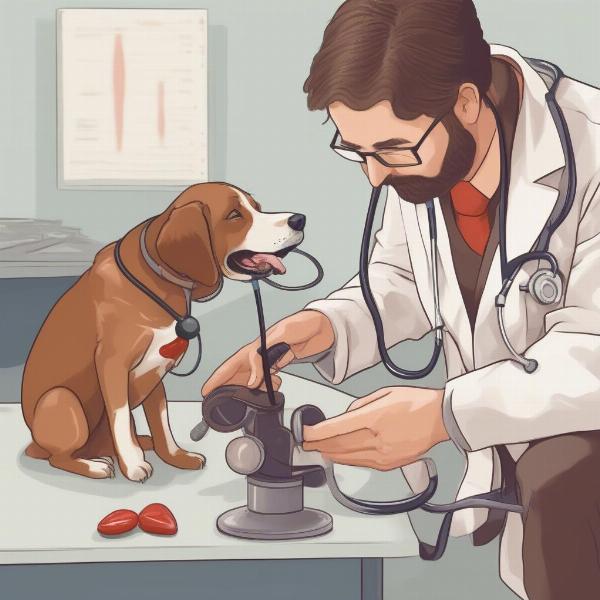Grain-free dog food has become increasingly popular, but is it the best choice for every dog? This comprehensive guide will explore the benefits and drawbacks of grain-free diets, helping you make an informed decision for your furry friend. We’ll delve into what grain-free actually means, why some dogs might benefit from it, and potential risks to consider. Choosing the right food is crucial for your dog’s health, so let’s explore grain-free dog food together.
Understanding Grain-Free Dog Food
Grain-free dog food, as the name suggests, doesn’t contain grains like wheat, corn, rice, barley, or rye. These grains are often used as fillers in cheaper dog foods. In grain-free formulas, these are replaced with alternative carbohydrate sources such as potatoes, sweet potatoes, peas, lentils, or tapioca. While some dogs genuinely benefit from a grain-free diet, it’s important to understand that not all dogs need it.
Why Choose Grain-Free Dog Food?
Some dogs have allergies or sensitivities to grains, which can manifest as itchy skin, digestive upset, or ear infections. For these dogs, a grain-free diet can be a game-changer. Grain-free foods can also offer benefits for dogs with sensitive stomachs, as they are often easier to digest. Furthermore, some owners believe grain-free diets contribute to healthier skin and a shinier coat.
Potential Risks of Grain-Free Diets
While grain-free diets can be beneficial for some dogs, it’s crucial to be aware of potential risks. In recent years, the FDA has investigated a potential link between grain-free diets and a heart condition called dilated cardiomyopathy (DCM) in dogs. More research is ongoing, but it’s important to discuss any dietary changes with your veterinarian, especially if your dog has a pre-existing heart condition. Choosing a high-quality grain-free food from a reputable brand is essential.
 Veterinarian Examining Dog
Veterinarian Examining Dog
Is Grain-Free Right for Your Dog?
The decision of whether to feed your dog a grain-free diet should be made in consultation with your veterinarian. They can assess your dog’s individual needs and health status to determine if a grain-free diet is appropriate. Factors to consider include your dog’s breed, age, activity level, and any existing health conditions.
Choosing the Right Grain-Free Dog Food
If you decide to go grain-free, choose a grain free dog food beef from a reputable brand that uses high-quality ingredients. Look for foods that meet AAFCO (Association of American Feed Control Officials) standards. Be sure to read the ingredient list carefully and avoid foods with artificial colors, flavors, or preservatives. Transitioning to a new food should be done gradually to avoid digestive upset. Start by mixing a small amount of the new food with the old food, gradually increasing the proportion of the new food over several days.
What if My Dog Doesn’t Need Grain-Free?
If your dog is thriving on a diet that includes grains, there’s no need to switch to grain-free. wheat and grain free dog food can offer some benefits, but a balanced diet with high-quality grains can be just as nutritious. Focus on providing your dog with a complete and balanced diet that meets their individual needs, regardless of whether it contains grains. Consider options like wellness grain free dog, langhams grain free dog food or merrick grain free dog food.
Conclusion
Grain-free dog food can be a beneficial option for dogs with grain allergies or sensitivities. However, it’s important to be aware of potential risks and to consult with your veterinarian before making any dietary changes. Choosing a high-quality food, whether grain-free or not, is crucial for your dog’s overall health and well-being. By understanding the benefits and drawbacks of grain-free diets, you can make an informed decision that’s right for your canine companion.
FAQ
- What are the most common grains found in dog food? The most common grains in dog food are wheat, corn, rice, barley, and rye.
- What are the signs of a grain allergy in dogs? Common signs include itchy skin, digestive upset, ear infections, and excessive licking or chewing of paws.
- Are all grain-free dog foods created equal? No, the quality of grain-free dog foods can vary significantly. Choose a reputable brand that uses high-quality ingredients.
- What are some good alternatives to grains in dog food? Common alternatives include potatoes, sweet potatoes, peas, lentils, and tapioca.
- Can puppies eat grain-free dog food? Always consult with your veterinarian before feeding a puppy a grain-free diet.
- Is grain-free dog food more expensive? Grain-free dog food can be more expensive than traditional dog food due to the alternative ingredients used.
- How do I transition my dog to a grain-free diet? Gradually mix the new food with the old food over several days to avoid digestive upset.
ILM Dog is a leading international website dedicated to providing expert advice and resources for dog owners worldwide. We cover a wide range of topics, from breed selection and healthcare to training, nutrition, and grooming. Our mission is to empower dog owners with the knowledge they need to provide the best possible care for their furry friends. Whether you are a seasoned dog owner or just starting your journey, ILM Dog is your go-to resource for all things canine. For personalized guidance and expert advice, please contact us at [email protected] or call us at +44 20-3965-8624. Connect with us today at ILM Dog!